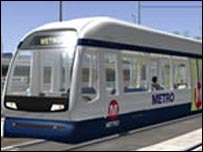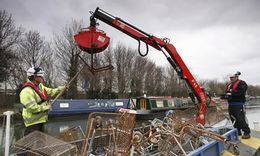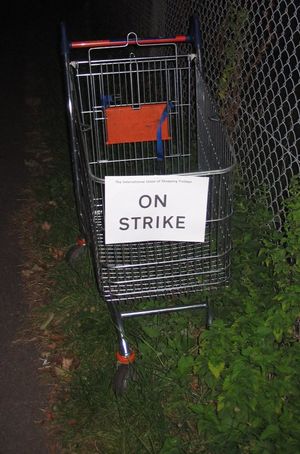Leeds Supertram

Leeds Supertram (also know as The Pride of West Yorkshire) forms part of the public transport infrastructure of the city of Leeds in Yorkshire, England.
History[edit | edit source]
The Leeds-Bradford area had an extensive tram network between 1891 and 1959. The whole network was eventually removed to make space for wider roads leaving the city as the largest urban area in Europe with no tram, underground or light rail network.
In the 1990s the South Yorkshire city of Sheffield invested in a new Supertram network, cementing Leeds' position as the crappest city in Yorkshire (if not England). Motivated by jealousy Leeds City Council quickly drew up plans for a Supertram of their own.
At first the government agreed to pay 75% of the cost, so Leeds City Council spent £40 million on drawing up plans to create a Supertram network to make Sheffield's look shit.
Cancellation[edit | edit source]
“Clearly it does not represent the best value for money for the people of Leeds or the best use of public money when we could spend it all on London instead”
In 2004 then transport secretary Alistair Darling cancelled the government contribution to the project stating that the £375 million would be better spent as a contribution towards the £15.9 billion London Crossrail scam.
After the withdrawal of government support the Supertram project had to be cancelled, causing much celebration and merriment in Sheffield.
Rebirth[edit | edit source]
In 2005 it was decided to redesign Leeds Supertram with greater budgetary constraints. A plan was drawn up for a cross city trolleybus service relying on pre-existing infrastructure such as supermarket carparks and public footpaths.
This redesigned scheme came in at an overall cost far lower than the amount originally wasted on designing the first set of plans.
The redesigned trolleybus service won praise from Environmentalist groups for the low carbon footprint of the carriages and the reuse of existing infrastructure.
Employment[edit | edit source]
Leeds Supertram employs many thousands of people across the city, the necessity of one driver per carriage creates employment opportunities for thousands of local people. Other related trades include the carriage repair works in Holbeck, the administration offices at Asda house, the shunting yards at Owlcoates and The White Rose Centre.
2008 Canal disaster[edit | edit source]
In 2008 the Supertram network experienced its first disaster when a crowded late night carriage on route to Kirkstall plunged into the Leeds-Liverpool canal killing all on board. it was later revealed at a public enquiry that the trolleybus drivers had been as drunk as the passengers.
A two week retrieval operation was necessary, resulting in the closure of the canal and the cancellation of all trolleybus services to West Leeds and Pudsey Owlcoates centre.
Eventually all of the damaged carriages were dredged from the canal, repaired and put back into service on the Kirkstall line.
Relatives of the victims held a protest at the Morrisons terminus at Kirkstall when the service was restored. They claimed that use of the exact same carriages their loved ones had drowned in was tasteless and hurtful. Leeds City Council claimed that the commissioning of new carriages would break the services environmental remit, and that it was impossible anyway, due to reductions in Leeds' public transport budget to pay for the 3rd runway at Heathrow Airport.
2009 strike[edit | edit source]
In 2009 the Supertram network experienced a 10 week strike, when council bosses attempted to round down the wages of male trolleybus operators to match the pitiful amount it pays to its female workers under a scheme entitled the Leeds Sexual Equality Act.
The mainly male drivers went on strike over the proposed pay cuts claiming that they would soon starve to death if forced to live on womens' wages, and argued that the council should increase the amount it pays to it's female workers instead of reducing theirs.
The strike finally came to an end when the drivers agreed minor pay cuts and accepted new increased productivity targets.



